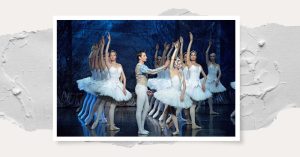The story of the Russian Ballet.
With over 500 years of history behind it, ballet has seen quite an evolution from its beginnings. Ballet started life as a courtly performance, evolving into the spectacular art we know today. We have looked at queens and kings who loved ballet, and a prima ballerina loved by all. Today we are moving to the start of modern ballet as we know it- Russia. Ballet flourished in the court and theatres of Russia in the nineteenth century. This quick history of ballet in Russia will explain a lot of what you see on stage today!

Peter the Great and Ballet
Peter the Great inherited quite a medieval Russia. Aristocrats and nobles still lived in simple wood homes, wore plain Russian dress, and lived relatively rough lives. However, Peter was not impressed with this and set out across Europe to change this. In addition to his time spent in London and England, Peter visited several European courts, including those in France and the Italian states. (You will remember that ballet flourished in both France and Italy….)
Peter strove to “European-ise” Russia, and bring it into the modern age. (What we would consider the early modern!) He idolised Louis XIV and his court. He adored Louis’s elegance and gravitas, the structure of his court, and the etiquette and ritual that came with it. And what was a major part of the French court? Ballet, of course! Peter’s court was structured with fourteen different ranks, with specific etiquette and rules for each rank.
To acquire proper comportment and manners, aristocratic children were taught to dance from an early age by French and Italian ballet masters, and courtiers were required to learn the latest dances for balls and ceremonial events….Classical ballet thus came to Russia as etiquette and not as art. This mattered: ballet was not initially a theatrical “show” but a standard of physical comportment to be emulated and internalized… Thus from the moment ballet entered Russia, it was inextricably bound up with the Westernizing project that would shape the country’s history for generations to come. (Apollo’s Angels, 247)
Catherine the Great and Ballet
Catherine the Great, another infamous Russian ruler, also pushed the boundaries of Russian ballet. She, like Peter, dreamed of a European Russia, and her cultural programs reflected this. Catherine established three different theatres in St. Petersburg, along with three companies. Although there was a strict code of etiquette, the theatres were open to people of any social class. Yes, it has to be said that Catherine largely decided what was in taste and therefore what would be performed, but it is one of the first cases of ballet being performed for anyone.
Russian theatres had an advantage over other European theatres. Many wealthy landowners ran their own “serf theatres”, their own estates mimicking Russia and the state theatres. These landowners were invested in ensuring that their own performers knew the latest dances and productions. It is debatable whether or not these theatres gave the serfs a better or worse than other serfs, but it did lead to a couple generations of culturally motivated and artistic serfs. Why is this important? It means that ballet was longer performed solely by the aristocracy and visiting European dancers.

Marius Petipa, the Father of Russian Ballet
Petipa is still a very common name to hear in ballet today and is crucial in the history of ballet in Russia. Although he died 110 years ago, his work still lives on in classical ballet to this day. Known for being the Father of the Russian Ballet, he was the St. Petersburg Imperial Theatres’ First Ballet Master from 1873 until 1901. A Frenchman, when he arrived in Russia, he was not particularly well-known. His career before was rather unremarkable. He worked as a choreographer and ballet master in Madrid and Paris for several years. In 1847, his more successful dancer brother, Lucien, arranged a position for him in the Imperial Theatres.
Petipa began his career in Russia as a lesser ballet master, under Jules Perrot. Because he wasn’t as well-known as many of the foreign dancers and creatives, he was paid less and had to spend years working up the ladder. Largely known for expanding the Romantic ballet, Perrot would stage ballets that were four to five hours in length, unheard of in Paris. Combining this French training from Perrot with inheriting the Bournonville tradition from the Swedish Johansson, also at the theatre, Petipa developed a mastery of ballet. He used this decade of training to his advantage.

Petipa went on to create many of the classical story ballets that we still know and love today. Four years after taking the helm of the Imperial theatres, he created La Bayadère, an exotic story about a temple dancer and her love. The Kingdom of the Shades with 32 dancers slowly travelling down the stage is still one of ballet’s most iconic images. Petipa also developed a close working relationship with composer Tchaikovsky. In 1890, The Sleeping Beauty premiered, a ballet still regularly staged today. Although it is a beloved production now, St. Petersburg audiences thought it was low-class and pandering.
Even today’s most skilled performers find Petipa’s fairy variations a test of classical precision: the slightest false move or cheat– a leg straying off centre or a step out of line — immediately shows and throws the whole dance into disarray… Performing these dances well is a matter of technical acuity and cast-iron discipline but also of style: a dancer cannot plausibly get through them without a modicum of charm. (Apollo’s Angels, 276-7.)
Petipa’s most famous ballet has to be The Nutcracker, though, performed for millions every holiday season.

Russian Ballet Companies
The first ballet company was the Imperial School of Ballet in St. Petersburg in the 1740s. Sergey Diaghilev, (1872–1929), an enormously important figure in the Russian ballet scene, founded the ballet company Ballets Russes in 1909. Diaghilev intervened in every aspect of ballet – direction, production, lighting, scenery, and performance. He headquartered his ballet company in Paris. Today, the Kirov Ballet company (now known as the Mariinsky Ballet) and the Bolshoi company are two world-renowned Russian ballet companies that tour the world.
- Mariinsky Ballet (formerly Kirov ballet)
- Bolshoi Ballet
Other Russian ballet companies include:
- Ballets Russes, founded in 1909
- Moscow State Academy of Choreography, commonly known as The Bolshoi Ballet Academy, founded in 1773
- Vaganova Academy of Russian Ballet, founded in 1738 as the Imperial Ballet School
- Saint Petersburg Eifman Ballet, founded in 1977
- Mikhailovsky Theatre Ballet, founded in the 1930s
- Perm Theatre Ballet, founded in 1896
- Novosibirsk Theatre Ballet, founded in 1945
- Russian State Ballet of Siberia, founded in 1978
- Moscow Stanislavski Ballet, founded in 1929
- Ballet Stars of Moscow Theaters with Anna Pavlova, 1888–1931
- Moscow Ballet Theater founded in 1966
- Moscow City Ballet, founded in 1988,
- Moscow Classical Ballet, founded in 1966.
- Moscow Dramatic Ballet, founded prior to 1992
- Moscow Festival Ballet, founded in 1989,
- Moscow Grand Ballet
- National Russian Ballet
- Moscow Folk Ballet
- Russian Festival Ballet, founded in 1989
- Russian National Ballet, founded in 1956
- The Imperial Russian Ballet Company
The most popular Ballet of all time. Swan Lake
Swan Lake is a ballet composed by Russian composer Pyotr Ilyich Tchaikovsky in 1875–76. Despite its initial failure, it is now one of the most popular ballets of all time.

The scenario, initially in two acts, was fashioned from Russian and German folk tales and tells the story of Odette, a princess turned into a swan by an evil sorcerer’s curse. The choreographer of the original production was Julius Reisinger (Václav Reisinger). The ballet was premiered by the Bolshoi Ballet on 4 March 1877 at the Bolshoi Theatre in Moscow. Although it is presented in many different versions, most ballet companies base their stagings both choreographically and musically on the 1895 revival of Marius Petipa and Lev Ivanov, first staged for the Imperial Ballet on 15 January 1895, at the Mariinsky Theatre in St. Petersburg. For this revival, Tchaikovsky’s score was revised by the St. Petersburg Imperial Theatre’s chief conductor and composer Riccardo Drigo.
The original production of 1877
The première on Friday, 4 March 1877, was given as a benefit performance for the ballerina Pelageya Karpakova (also known as Polina Karpakova), who performed the role of Odette, with première danseur Victor Gillert as Prince Siegfried. Karpakova may also have danced the part Odile, although it is believed the ballet originally called for two different dancers. It is now common practice for the same ballerina to dance both Odette and Odile.

The Russian ballerina Anna Sobeshchanskaya was originally cast as Odette, but was replaced when a governing official in Moscow complained about her, claiming she had accepted jewelry from him, only to then marry a fellow danseur and sell the pieces for cash.
The première was not well received. Though there were a few critics who recognised the virtues of the score, most considered it to be far too complicated for ballet. It was labelled “too noisy, too ‘Wagnerian’ and too symphonic.”The critics also thought Reisinger’s choreography was “unimaginative and altogether unmemorable.” The German origins of the story were “treated with suspicion while the tale itself was regarded as ‘stupid’ with unpronounceable surnames for its characters.” Karpakova was a secondary soloist and “not particularly convincing.”

Yet the fact remains (and is too often omitted in accounts of this initial production) that this staging survived for six years with a total of 41 performances – many more than several other ballets from the repertoire of this theatre.

How did you like the post? SURVEY
_______________________________________________________________________________
More inspiration you can find on my Instagram @atlas_of_inspiration
________________________________________________________________________________
All posts:
Sharing Inspiration. Introduction
Sharing Inspiration. The World of Fabergé. Part 1
Sharing Inspiration. The World of Fabergé. Part 2
Sharing Inspiration. The World of Fabergé. Part 3
Sharing Inspiration. The World of Fabergé. Part 4
Sharing Inspiration. The World of Fabergé. Part 5
Sharing Inspiration. The World of Fabergé. Part 6
Sharing Inspiration. Russian Ballet. Part 2
Sharing Inspiration. Russian Ballet. Part 3
Sharing Inspiration. Russian Ballet. Part 4
Sharing Inspiration. Russian Ballet. Part 5
Sharing Inspiration. Cultural Diversity. Part 1
Sharing Inspiration. Cultural Diversity. Part 2
Sharing Inspiration. Cultural Diversity. Part 3
Sharing Inspiration. Cultural Diversity. Part 4
Sharing Inspiration. Cultural Diversity. Part 5
________________________________________________________________________________
Sources:
anhistorianabouttown.com ballet-imperial.ru www.mariinsky.ru Wikipedia.SwanLake Wikipedia.RussianBallet





